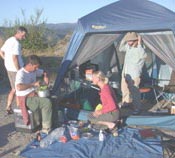 |
What We Do |
|
| The research in my lab is centered on the mechanisms that control vegetation recovery. Since its eruption in 1980, I have studied developing patterns on Mount St. Helens. The fundamental task each year is to record the status of vegetation in about 100 permanent plots and in several hundred plots that constitute grids. From these data, I have been able to compare recovery patterns in a variety of habitats and to document spatial spread and species turnover.
Recently, I have focused on the role of chance in the early establishment of vegetation and the way in which deterministic factors may begin to be exerted. The fundamental question of these studies is "to what degree does vegetation converge towards a single community?" Other recent studies have explored the importance of lupines (are you better off or worse off living with lupines?) and how biologically rich local sites (hot spots) affect the surroundings. Landscape effects and the importance of nearby potential colonists have been a major focus of the recent work. For more detail, see the Mount St. Helens page. Michael Fleming is studying elk that thrive on Mount St. Helens. Do elk promote or retard succession? They consume a lot of herbaceous material, but they also create disturnbances that permit seeds to establsih, and they transport seeds both internally and externally. Time will tell... Rachel Sewell Nesteruk came to the University of Washington because of her interest in large, infrequent disturbances. She is currently working on fungal endophyte diversity in lupines across a gradient of disturbance severity, as well as documenting fungal endophyte dispersal mechanisms. |